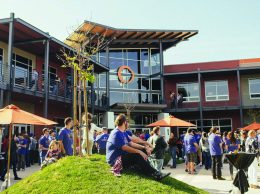COVID-19 challenging for tri-county spas and salons
IN THIS ARTICLE
- Central Coast Topic
- Marissa Nall Author
By Marissa Nall Friday, March 27th, 2020
Prior to the outbreak of the COVID-19 virus, the region’s salon and spa businesses had witnessed a transformation of their business model, moving toward memberships and express services as customers integrated them into a broad approach to wellness.
In recent weeks, though, the heavily touch-based businesses have been among the hardest hit by shelter-in-place orders that aim to stop the virus’s spread.
“We’re seeing this as an opportunity to figure out ways to serve the needs of our guests a little bit better,” said Natasha Prybyla, owner of Sloco Massage in San Luis Obispo.
In the months leading up to the closures, salon and spa businesses were seeing the same business model disruption that previously hit the fitness industry, said Amaya Weddle, vice president of research and product marketing at Mindbody, in a report prepared for the Business Times.
Dubbing them “boutique beauty and grooming” firms, the new entrants, “capitalize on easily bookable, ‘snackable’ beauty services consumers can get on the go, or pop into during a 30-minute lunch break,” Weddle said.
For Prybyla, a certified B Corp, that’s meant developing a new membership option, so customers can drop in for quick, high-demand services like cryotherapy and dry salt therapy, which can each be done in under 15 minutes, or 20-minute somadome meditation pods.
“We’re hearing from them that finding an hour once a month for themselves was really challenging,” she said. “Over time we were seeing that people just wanted more express services.”
The change reflects her approach to wellness, she said, which positions the services as part of a therapeutic, preventative regimen to help boost the immune system and recovery.
“We spend a lot of time in front of a computer, or in a car, and those things can be hard on your body,” she said. “I think it’s just teaching people to be curious about their health and listen to their body. Coming in once a month isn’t going to create a wellness lifestyle, but it’s a good place to start.”
Heading into 2020, the business was growing at 30-40 percent per year, she said, including a January that brought in record revenue. In February, the company was on track to make $1 million in sales for the year, but shelter-in-place orders that came down from San Luis Obispo County March 19 brought business to a standstill, and Sloco Massage was forced to lay off its 15 employees.
Prybyla said she plans to offer retail products through an online store in the coming days, but she’s taking the downtime as an opportunity to do some long-term planning for the business, including revamping the menu and pricing.
A la carte services have been on the menu for Carlyle Salon and Style Bar in Santa Barbara since it opened seven years ago, said owner Lisa Gaede.
“I knew I wanted to do a simple menu, and that’s really taken off,” Gaede said.
While salon and spa treatments have traditionally been viewed as a luxury, customers are increasingly choosing low-maintenance options and looking at quick appointments for things like blowouts as an efficient styling alternative, she said.
“It’s a little bit about pampering themselves, but they’re also saving themselves time because they’re not having to take the time to do it at home.”
The salon closed shortly before the orders went out from the county, Gaede said, and all but one administrative employee was laid off. Since then, it has stayed connected with clients through email and social campaigns, helping set up delivery of products through their distributors.
In the meantime, Gaede and Prybyla said they’ve tried to cut costs in other ways, including talking to landlords and vendors, downgrading services like text messaging for customers, and taking advantage of offers for free digital tools like Adobe, MindBody and Shopify.
“I’ve been just trying to find little expenses that might add up, but it’s amazing how many companies are stepping up to help small businesses,” Prybyla said.
As businesses and consumers shift toward boutique offerings, MindBody estimates the segment will grow some 15 percent annually through 2025.
Moreover, Weddle found, they’re more likely to have multiple locations or franchises, sell more memberships and packages than typical salon and spa businesses, and rely more on technology for bookings, with mobile discovery a critical element in their growth.
Even prior to the outbreak, live streaming and virtual offerings were also on the rise.
“With the growth of on-demand and live streaming products like Peloton and others, business owners are looking for solutions to keep their customers engaged inside and outside of the studio,” Weddle said, with a third of customers on the MindBody app incorporating digital workouts into their routines.
In response to the outbreak, MindBody accelerated its development of a video platform for its customers, said CEO Rick Stollmeyer.
The impacts have stretched across the wellness industry, “and the stakes are incredibly high for them,” Stollmeyer said in a statement to the Business Times. “Many have seen their revenue severely reduced or even shut off entirely by the crisis.”
While she expects to see a return to the long-term trend after the global health crisis has passed, not knowing when the restrictions will lift makes it difficult to communicate with clients and plan for reopening, Gaede said.
“We want them coming back to us and we want to keep them as clients,” she said. “It’s probably going to be overwhelming, to be honest.”
• Contact Marissa Nall at [email protected].












